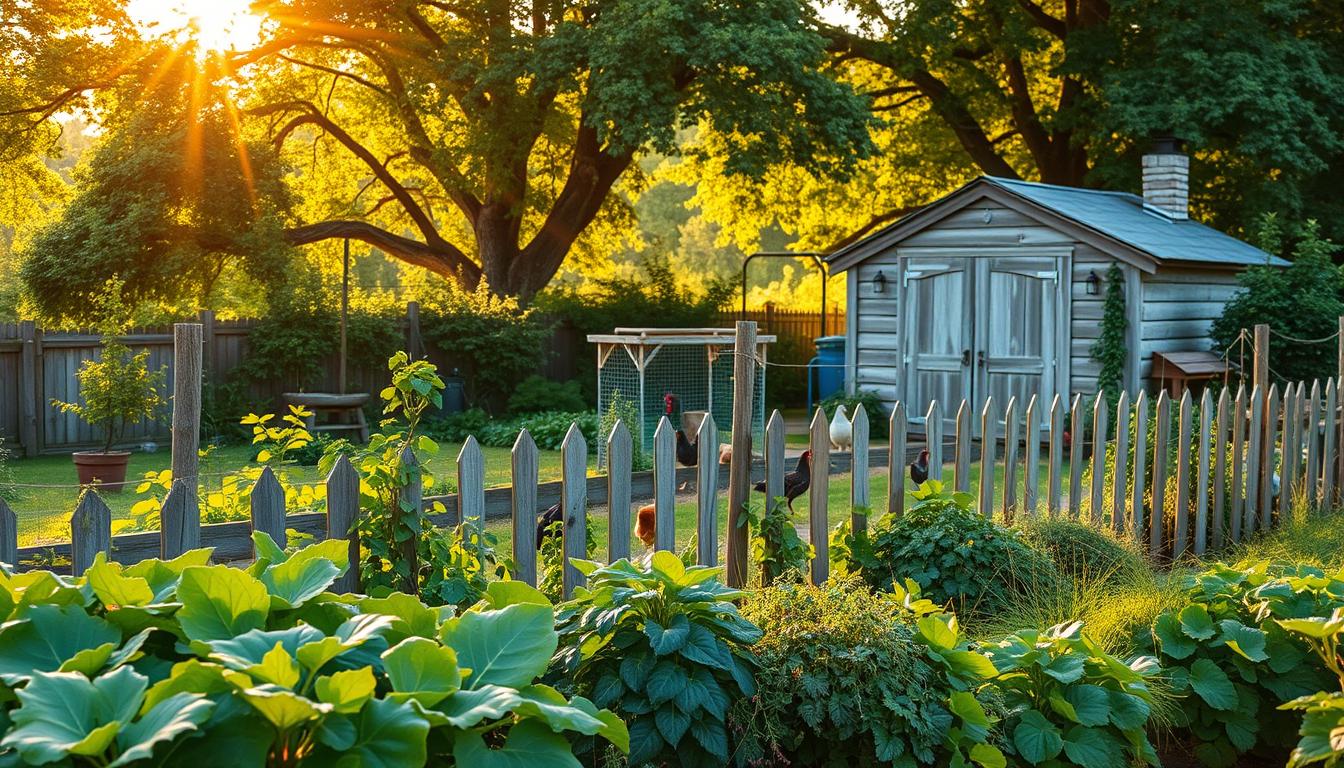In today’s fast-paced world, more people are turning to backyard homesteading as a way to live sustainably. This modern approach combines eco-friendly practices with urban or suburban living. It’s a myth that homesteading requires vast rural farmland. With creativity, even small spaces can become productive hubs for growing food and raising micro-livestock.
Interest in self-sufficiency has surged globally, especially after supply chain disruptions. According to USDA data, urban gardening participation has increased by 61% since 2020. This shift reflects a growing desire for food security and cost savings. By producing your own food, you can reduce grocery expenses by 25-40%.
Backyard homesteading isn’t just about saving money. It’s a gateway to eco-conscious living with mental health benefits. Activities like gardening and caring for animals can reduce stress and improve well-being. This article will guide you through a 10-step roadmap to start your journey, even in limited spaces.
Key Takeaways
- Backyard homesteading is a sustainable solution for urban and suburban living.
- It doesn’t require large rural spaces; small areas can be highly productive.
- Urban gardening participation has risen by 61% since 2020.
- Home food production can cut grocery costs by 25-40%.
- It promotes eco-conscious living and mental well-being.
What is Backyard Homesteading?
Modern homesteading adapts traditional practices to fit today’s urban lifestyle. It’s about intentionally producing food, energy, and goods in small spaces. Unlike the 19th-century Homestead Act, which required 160 acres, this approach thrives in balconies, patios, or quarter-acre plots.
Today, 83% of U.S. homesteaders live in urban or suburban areas. This shift reflects a growing trend toward self-sufficiency. From balcony herb gardens to permaculture systems, the possibilities are endless.
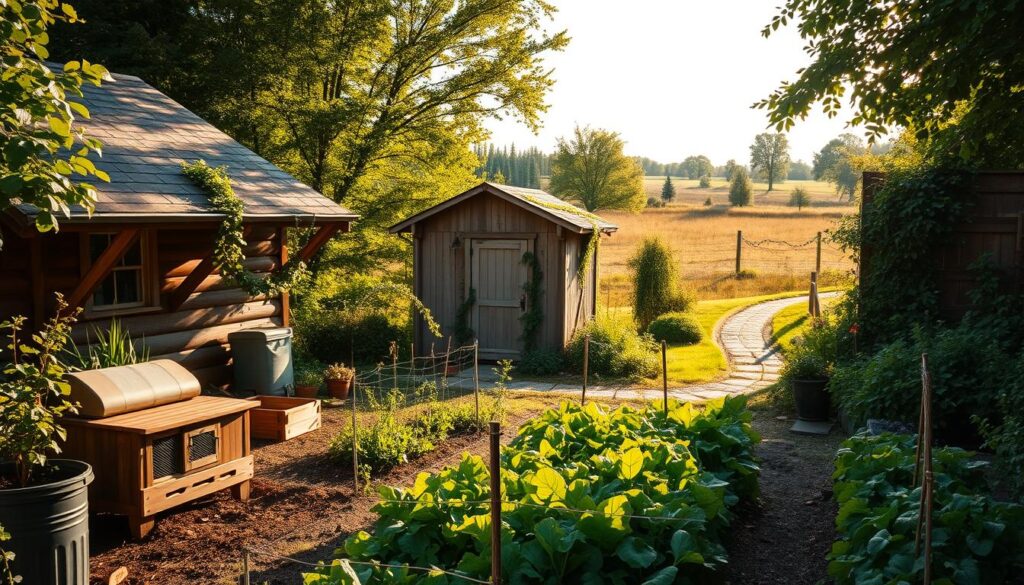
Core principles include waste reduction, renewable resources, and skill development. For example, edible landscaping combines beauty with functionality. This concept, known as “stacked functions,” maximizes space and efficiency.
“Homesteading is not about the size of your land but the depth of your commitment to sustainable living.”
Zoning laws have evolved to support this movement. Chickens are now allowed in 68% of major U.S. cities. Historical precedents, like WW2 victory gardens, show how small-scale production can make a big impact.
Many believe homesteading requires significant time and money. However, it’s more about smart planning and gradual progress. It’s a lifestyle choice, not just a hobby.
| Traditional Homesteading | Modern Backyard Homesteading |
|---|---|
| 160 acres or more | Small urban or suburban spaces |
| Rural focus | Urban and suburban focus |
| Limited by location | Adaptable to any space |
For more inspiration on sustainable living, check out our guide on glamping vs. traditional camping. Whether you’re starting small or dreaming big, backyard homesteading offers a path to a more sustainable future.
Why Start a Backyard Homestead?
Embracing a self-sufficient lifestyle has never been more rewarding. Whether you’re looking to save money, improve your health, or build a stronger community, starting a backyard homestead offers countless benefits. Let’s explore why this sustainable choice is worth your time and effort.
One of the biggest advantages is cost savings. A 2023 study found that growing your own vegetables can save you up to $600 annually per 100 square feet. Imagine reducing your grocery bills while enjoying fresh, organic produce right from your yard.
Health benefits are another major perk. Homegrown fruits and vegetables contain up to 40% more nutrients compared to store-bought options. Plus, gardening has been shown to reduce stress markers by 72%, making it a powerful tool for mental well-being.
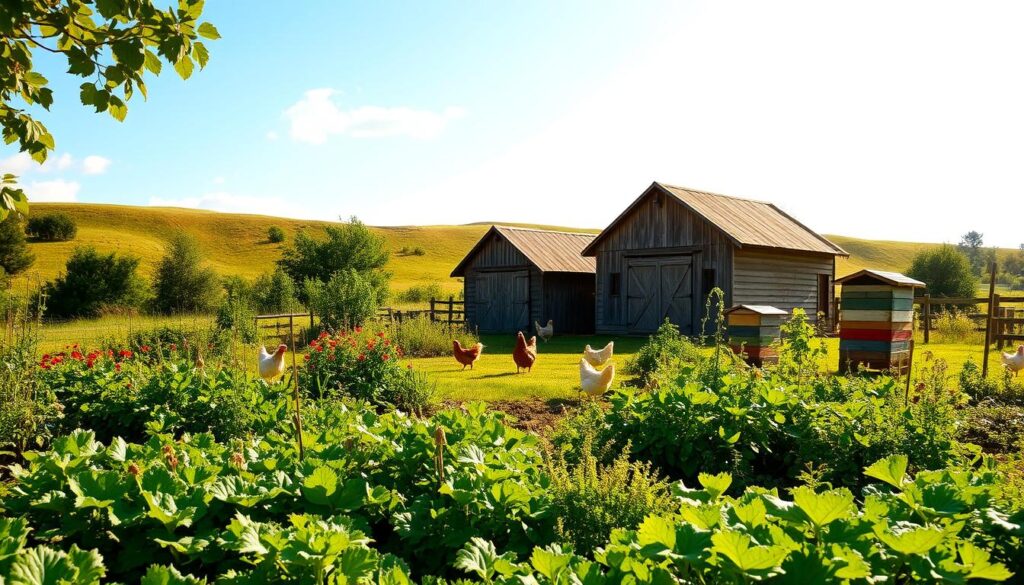
For families, homesteading provides unique educational opportunities. Children can learn STEM concepts through hands-on activities like planting, composting, and animal care. It’s a fun way to teach responsibility and sustainability.
In times of crisis, a backyard homestead can be a lifesaver. While the average U.S. home has a 3-day food supply, homesteaders often maintain a 30-day pantry. This resilience ensures you’re prepared for unexpected challenges.
Environmental impact is another key factor. Growing your own food saves 0.8 pounds of CO2 per pound of produce. Additionally, community initiatives like seed libraries in over 1,400 U.S. libraries foster collaboration and resource sharing.
| Homegrown Produce | Store-Bought Produce |
|---|---|
| 40% more nutrients | Lower nutrient density |
| $600 annual savings per 100 sq ft | Higher grocery costs |
| 0.8 lbs CO2 saved per lb | Higher carbon footprint |
Homesteading also empowers you with valuable skills. From preserving food to building DIY rain barrels, it’s a creative outlet that fosters independence. Plus, it’s a stepping stone for those dreaming of larger rural homesteads.
By starting a backyard homestead, you’re not just growing food—you’re cultivating a healthier, more sustainable future for yourself and your family.
How to Begin Your Backyard Homesteading Journey
Starting your journey toward self-sufficiency doesn’t have to be overwhelming. With a little planning and creativity, you can transform your space into a productive hub. The key is to take small steps and focus on what works best for your unique situation.
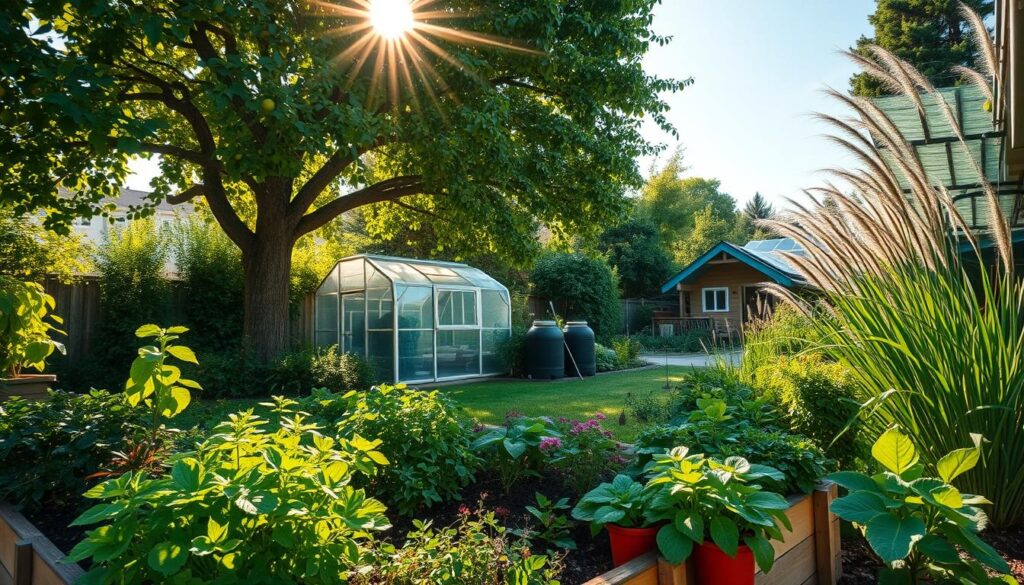
Assess Your Space
Before diving in, evaluate your available area. Sunlight is crucial for plant growth, so use tools like SunCalc.org to map sunlight patterns. Soil testing kits, often under $20, can reveal pH and nutrient levels, helping you choose the right plants.
Consider microclimates in your space. Urban heat islands can extend growing seasons, giving you more flexibility. Vertical gardening is another great way to maximize limited areas—18-inch deep shelves can hold up to 72 plants.
Don’t forget to check local zoning laws, especially if you plan to raise animals. Resources like Municode.com provide up-to-date ordinances. Noise management is also important—quail, for example, are quieter than chickens in urban settings.
Start Small
It’s easy to get excited and want to do everything at once. Instead, take small steps to build confidence and avoid burnout. Begin with container gardens or a few herbs on your windowsill. These are low-maintenance and perfect for beginners.
Water access is another factor to plan for. Decide whether a hose or watering can works best for your setup. As you gain experience, you can expand to larger projects like raised beds or composting systems.
Remember, the journey to self-sufficiency is a gradual process. By starting small and focusing on your available resources, you’ll set yourself up for long-term success.
Essential Elements of a Backyard Homestead
Creating a productive space for sustainable living starts with the basics. Whether you’re new to self-sufficiency or looking to optimize your setup, focusing on these key elements will set you up for success. From growing areas to water access and composting, each component plays a vital role in building a thriving homestead garden.
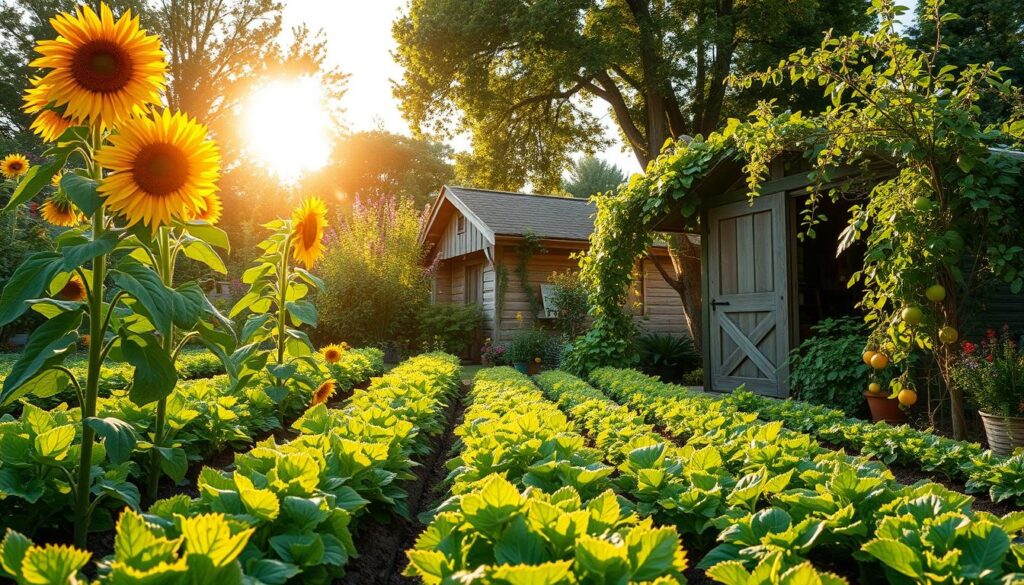
Growing Space
Your homestead garden needs a well-planned growing area. Square foot gardening is a popular method, yielding up to 1 pound of vegetables per square foot. This efficient use of space is perfect for small areas.
Cold frame designs can extend your growing season by 6-8 weeks, allowing you to harvest fresh produce longer. Succession planting schedules ensure a continuous supply of plants, while pollinator corridors can boost yields by up to 30%.
Don’t forget to test your soil before planting. A simple kit can reveal pH and nutrient levels, helping you choose the right crops. Healthy soil is the foundation of a thriving garden.
Water Source
Access to water is crucial for any garden. Whether you use a hose, watering can, or drip irrigation system, consistency is key. Rainwater harvesting is an eco-friendly option that reduces reliance on municipal supplies.
Consider installing a rain barrel to collect and store water. This simple addition can save you money and ensure your plants stay hydrated during dry spells. Proper water management is essential for long-term success.
Composting System
A composting system turns waste into valuable nutrients for your garden. Start with a small bin in your kitchen for food scraps, then transfer them to a larger outdoor compost pile.
Composting reduces landfill waste and enriches your soil. Use a mix of green materials (like vegetable scraps) and brown materials (like leaves) for the best results. Over time, you’ll create nutrient-rich compost that boosts plant growth.
“Composting is nature’s way of recycling. It’s simple, sustainable, and incredibly rewarding.”
By focusing on these essential elements, you’ll build a functional and productive space that supports your self-sufficiency goals. Start small, plan carefully, and watch your garden thrive.
Backyard Homesteading Ideas to Inspire You
Transform your space into a thriving hub of productivity with these inspiring ideas. Whether you’re a beginner or a seasoned enthusiast, these projects will help you maximize your resources and create a sustainable lifestyle. Let’s dive into some creative and practical ways to enhance your setup.
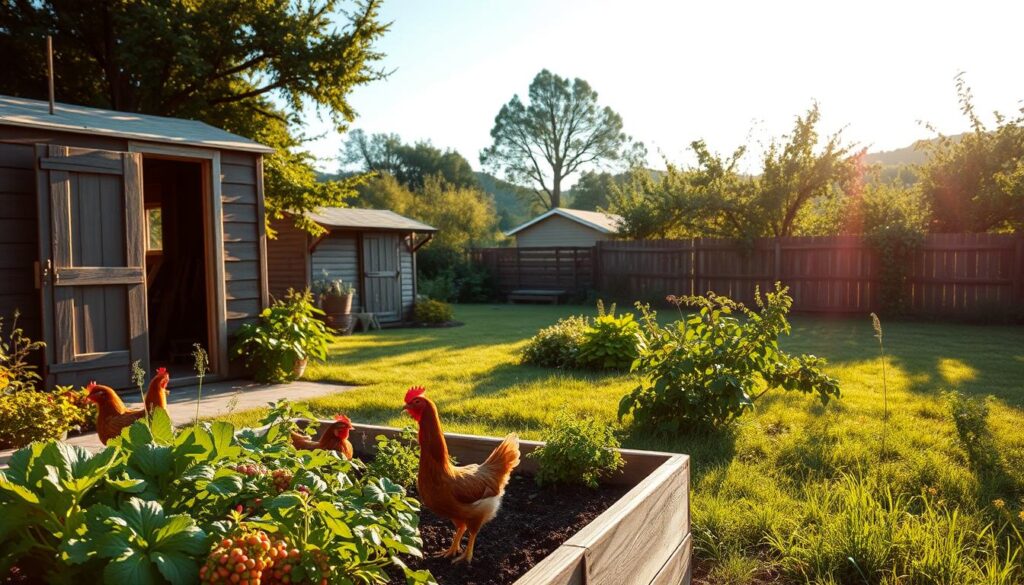
Raise Chickens or Quail
One of the most rewarding projects is raising chickens or quail. These animals provide fresh eggs and can be a great addition to your self-sufficient lifestyle. Homegrown eggs cost around $3 per dozen, compared to $6 at the store, making it a cost-effective choice.
Start with a brooder setup, maintaining an initial temperature of 95°F and decreasing it weekly. Check local municipal requirements, as most areas require at least 4 square feet per hen. Quail are quieter and require less space, making them ideal for urban settings.
Build a Fire Pit
A fire pit is more than just a cozy gathering spot—it’s a practical addition to your space. Use it for cooking, warmth, or even disposing of yard waste. Choose a safe location, away from structures and overhanging trees.
Materials like bricks, stones, or metal rings are durable and easy to work with. A well-designed fire pit can become the centerpiece of your outdoor area, offering both functionality and charm.
Create a Greywater System
Maximize water efficiency by setting up a greywater system. This eco-friendly solution recycles water from sinks, showers, and laundry for irrigation. It’s a great way to reduce water waste and keep your garden thriving.
Start with a simple setup using a diverter valve and a storage tank. Ensure the water is free of harmful chemicals before using it on plants. Over time, you can expand the system to cover more areas of your garden.
“Sustainability isn’t just a goal—it’s a way of life. Every small step counts.”
These backyard homestead ideas are just the beginning. With a little creativity and effort, you can turn your space into a sustainable haven that benefits both you and the environment.
Overcoming Challenges in Backyard Homesteading
Every journey toward self-sufficiency comes with its own set of challenges. While the rewards are plentiful, addressing these hurdles is essential for long-term success. From pest management to neighbor relations, here’s how to navigate common obstacles in a thoughtful and effective way.
Pest management is a top concern for many. Row covers, for example, can prevent up to 85% of cabbage losses. These simple tools protect your crops without harmful chemicals, ensuring a healthier harvest. Regularly inspecting plants and using natural deterrents like neem oil can also make a big difference.
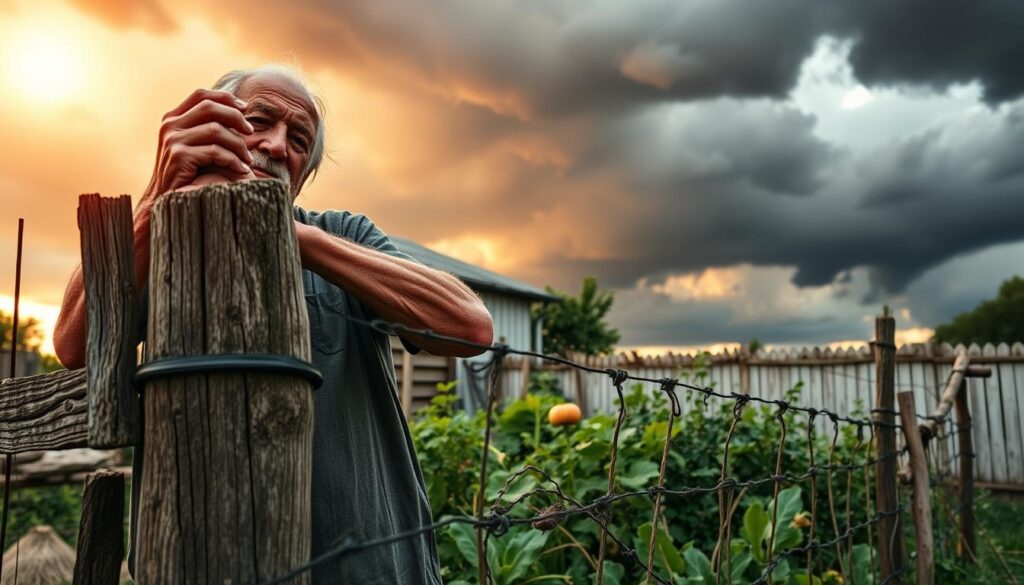
Time management is another critical factor. Dedicate at least 15 minutes daily to maintenance tasks like watering, weeding, and pruning. This small investment of time keeps your space thriving and prevents larger issues down the road. Prioritize tasks based on urgency to stay organized.
Neighbor relations can be tricky, especially in urban settings. Sharing fresh eggs or produce, often called “egg diplomacy,” can reduce complaints by 67%. Open communication and thoughtful gestures go a long way in fostering goodwill. Consider hosting a garden tour to showcase your efforts and build community connections.
Wildlife solutions are also important. Motion-activated sprinklers can deter animals like deer and raccoons without harming them. Fencing and netting are other effective options. By protecting your crops, you ensure a bountiful harvest while respecting local wildlife.
Failure is part of the process. If crops don’t thrive, resow them promptly using a well-planned timeline. Learning from setbacks builds resilience and improves your skills over time. Keep a journal to track what works and what doesn’t for future reference.
Energy efficiency is another area to focus on. LED grow lights, for instance, use just 32 watts per square foot while providing ample light for plants. This eco-friendly choice reduces energy costs and supports sustainable practices. Solar-powered tools are another great option.
Legal navigation is essential, especially for front-yard gardens. Ensure compliance with ADA regulations and local zoning laws. Resources like Municode.com can help you stay informed. By following the rules, you avoid fines and maintain a positive relationship with your community.
Burnout prevention is equally important. Crop rotation reduces chore monotony and keeps your garden healthy. Take breaks when needed and celebrate small victories along the way. Remember, homesteading is a marathon, not a sprint.
“Challenges are opportunities in disguise. Each one teaches valuable lessons and strengthens your commitment to sustainability.”
By addressing these challenges head-on, you’ll create a thriving and sustainable space that brings joy and fulfillment. Embrace the process, learn from setbacks, and enjoy the journey toward self-sufficiency.
Pros and Cons of Backyard Homesteading
Balancing the benefits and challenges of a self-sufficient lifestyle is key to success. Whether you’re looking to save money or reduce waste, understanding the ups and downs helps you make informed decisions. Let’s explore the advantages and obstacles of this rewarding path.
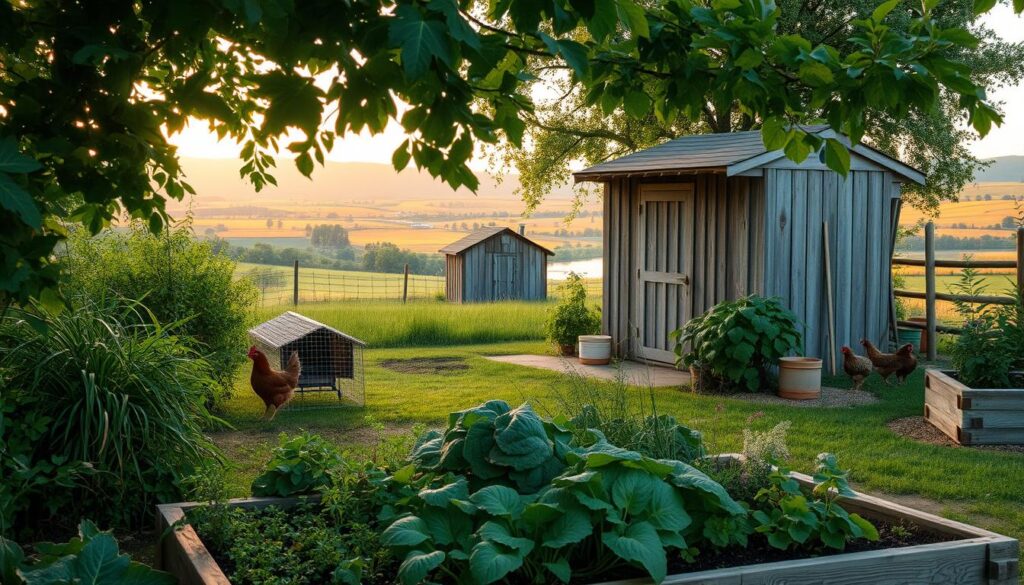
One of the biggest pros is simplicity. Urban homesteaders report a 92% satisfaction rate, with many committing for an average of 4.7 years. This long-term dedication reflects the joy and fulfillment it brings. Additionally, households see a 38% reduction in waste, making it an eco-friendly choice.
Financial savings are another major benefit. Growing your own food can help you save money on groceries while providing fresh, organic produce. For families, it’s a great way to teach kids about sustainability and responsibility.
However, there are challenges to consider. Labor-intensive tasks like gardening and animal care require time and effort. Regulations can also be a hurdle, especially in urban areas. Checking local zoning laws is essential to avoid fines or disputes.
| Pros | Cons |
|---|---|
| 92% satisfaction rate | Labor-intensive tasks |
| 38% waste reduction | Local regulations |
| Cost savings on groceries | Time commitment |
“Homesteading is a journey of balance. Embrace the rewards, learn from the challenges, and enjoy the process.”
By weighing the pros and cons, you can create a sustainable lifestyle that fits your needs. Start small, stay informed, and enjoy the journey toward self-sufficiency.
Backyard Homesteading Projects to Try
Looking for ways to enhance your self-sufficient lifestyle? Try these hands-on projects. Whether you’re working with a small homestead or just starting out, these ideas will help you maximize your space and resources. From food preservation to landscaping, there’s something for everyone.

Build a Smokehouse
Preserving food is a key part of self-sufficiency, and building a smokehouse is a great way to start. Cold smoking at 80°F and hot smoking at 225°F offer different flavor profiles. Applewood, for example, adds a 17% flavor preference compared to other woods.
Safety is crucial when smoking meat. Ensure the internal temperature reaches at least 145°F to prevent foodborne illnesses. A well-built smokehouse can become a centerpiece of your homestead projects, providing delicious, preserved food year-round.
Grow an Edible Hedge
An edible hedge is both functional and beautiful. It provides privacy while offering fresh fruits, herbs, or vegetables. Choose plants like blueberries, rosemary, or currants for a mix of aesthetics and utility.
This project is perfect for a small homestead, as it maximizes vertical space. Regular pruning ensures healthy growth and a bountiful harvest. Plus, it’s a sustainable way to enhance your landscape.
Start a Worm Farm
Improving your soil quality is essential for a thriving garden. A worm farm is an eco-friendly way to produce nutrient-rich compost. Worms break down kitchen scraps into valuable fertilizer, boosting plant growth.
Setting up a worm farm is simple and requires minimal space. Use a bin with proper drainage and add a mix of green and brown materials. Over time, you’ll have a steady supply of compost to enrich your garden.
“Every project is a step toward a more sustainable and self-sufficient lifestyle. Start small, stay consistent, and enjoy the journey.”
Conclusion
Taking small steps toward sustainability can lead to big changes. Whether you’re growing herbs on a windowsill or raising chickens, every effort counts. The USDA offers urban agriculture grants to support your journey, making it easier to start your self-sufficient lifestyle.
Local homesteading communities are thriving, with clubs in 82% of U.S. counties. These groups provide support, resources, and inspiration. Did you know that just one acre can feed a family of four annually? It’s proof that even small spaces can make a big impact.
Ready to begin? Take our 30-day starter challenge and explore our top 5 beginner books. As Abraham Lincoln said, “The greatest fine art of the future will be making a comfortable living from a small piece of land.” Embrace smart tech integration and remember: Every zucchini starts as a seed.

